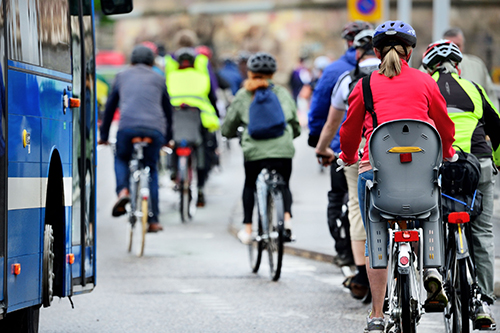Pooling Resources to Improve Road Safety
A new project to make streets safer for pedestrians, cyclists, and other vulnerable road users is using an innovative funding model that allows multiple sponsors to benefit from a single research agenda.
The National Association of City Transportation Officials (NACTO) is pooling funds from Boston, Chicago, Los Angeles, San Francisco, Seattle, and Washington, D.C., to support a U.S. DOT Volpe Center project that will develop best practices for two technologies that can help truck drivers avoid or mitigate collisions with pedestrians and bicyclists.

Experts from the Volpe Center and NACTO will consider vehicle cab designs that reduce blind spots without mirrors, cameras, or other indirect vision add-ons, and emergency braking technologies that activate brakes automatically to prevent or mitigate forward collisions. (Conneldesign/123RF photo)
“While trucks make up only 4 percent of the vehicles in large cities, they have an outsize impact in street safety,” said Linda Bailey, executive director of NACTO. “NACTO is excited about this work with Volpe because it will help our cities look at how large vehicles can be adapted to more safely interact with people on foot and on bikes, instead of having cities design less-safe streets to accommodate large vehicles. By working together, cities can more effectively achieve their policy goals and objectives—by pooling our resources, we can make our streets safer for everyone.”
A Focus on Direct Vision and Automatic Emergency Braking
The six-city working group, with input from the Volpe and NACTO project leads, originally considered fifteen technologies before settling on two: improved direct vision and automatic emergency braking.
The improved direct vision review will consider vehicle cab designs that reduce blind spots without mirrors, cameras, or other indirect vision add-ons. The automatic emergency braking evaluation will consider technologies that activate brakes automatically to prevent or mitigate forward collisions.
“Instead of six individual projects with administrative and setup costs, you give up a little in individuality in exchange for cost savings and knowledge sharing,” said Volpe community planner Margo Dawes, who is co-leading the project with engineer Alex Epstein. “It turns out, these cities have lots of overlap in their research goals, and through their participation in the Vision Zero Vehicle Safety Technology Working Group, they get to set the research agenda and make sure their specific contexts are represented.”
When the research is complete, Dawes and Epstein will provide the working group cities with best practices for selecting and potentially implementing those technologies in their truck fleets.
“There is a lot of potential synergy between this project and others at Volpe, such as investigations into truck emergency braking and collision-avoidance human factors work,” Epstein said. “We’re also advising an Olin College engineering project related to direct vision. So we’re taking advantage of natural overlaps to make the whole of this project greater than the sum of its parts.”
An Adaptable Roadmap
After the best practices are completed, Dawes and Epstein will create an adaptable roadmap to inform and empower the working group cities to implement these safety technologies.
“This working group also identified a limitation in that they have these shared research interests and priorities but they are not necessarily able to speak with one voice on a national level,” Dawes said. “So we’re also exploring how the working group can amplify the individual contributions of the member cities—how can this project framework be a way for cities to talk about what they are doing that’s working well, and give members an opportunity to share knowledge and expertise?”
